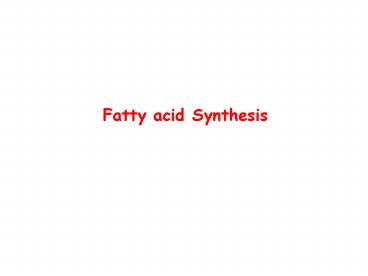Fatty acid Synthesis PowerPoint PPT Presentation
Title: Fatty acid Synthesis
1
- Fatty acid Synthesis
2
Fatty Acid Synthesis
- In mammals fatty acid synthesis occurs primarily
in the liver and adipose tissues - Also occurs in mammary glands during lactation.
- Fatty acid synthesis and degradation go by
different routes - There are four major differences between fatty
acid breakdown and biosynthesis
3
The differences between fatty acid biosynthesis
and breakdown
- Intermediates in synthesis are linked to -SH
groups of acyl carrier proteins (as compared to
-SH groups of CoA) - Synthesis in cytosol breakdown in mitochondria
- Enzymes of synthesis are one polypeptide
- Biosynthesis uses NADPH/NADP breakdown uses
NADH/NAD
4
ACP vs. Coenzyme A
- Intermediates in synthesis are linked to -SH
groups of acyl carrier proteins (as compared to
-SH groups of CoA)
5
Fatty Acid Synthesis Occurs in the Cytosol
- Must have source of acetyl-CoA
- Most acetyl-CoA in mitochondria
- Citrate-malate-pyruvate shuttle provides
cytosolic acetate units and reducing equivalents
for fatty acid synthesis
6
Fatty Acid Synthesis
- Fatty acids are built from 2-C units derived from
acetyl-CoA - Acetate units are activated for transfer to
growing FA chain by conversion to malonyl-CoA - Decarboxylation of malonyl-CoA and reducing power
of NADPH drive chain growth - Chain grows to 16-carbons (eight acetyl-CoAs)
- Other enzymes add double bonds and more Cs
7
Acetyl-CoA Carboxylase
Acetyl-CoA HCO3- ATP ? malonyl-CoA ADP
- The "ACC enzyme" commits acetate to fatty acid
synthesis - Carboxylation of acetyl-CoA to form malonyl-CoA
is the irreversible, committed step in fatty acid
biosynthesis
8
Acetyl-CoACarboxylase
9
Regulation of Acetyl-CoA Carboxylase (ACCase)
- ACCase forms long, active filamentous polymers
from inactive protomers - Accumulation of palmitoyl-CoA (product) leads to
the formation of inactive polymers - Accumulation of citrate leads to the formation of
the active polymeric form - Phosphorylation modulates citrate activation and
palmitoyl-CoA inhibition
10
Regulation of Acetyl-CoA Carboxylase (ACCase)
- Unphosphorylated ACCase has low Km for citrate
and is active at low citrate - Unphosphorylated ACCase has high Ki for
palmitoyl-CoA and needs high palmitoyl-CoA to
inhibit - Phosphorylated E has high Km for citrate and
needs high citrate to activate - Phosphorylated E has low Ki for palmitoyl-CoA and
is inhibited at low palmitoyl-CoA
11
Fatty Acid Synthesis
- Step 1 Loading transferring acetyl- and
malonyl- groups from CoA to ACP - Step 2 Condensation transferring 2 carbon unit
from malonyl-ACP to acetyl-ACP to form 2 carbon
keto-acyl-ACP - Step 3 Reduction conversion of keto-acyl-ACP
to hydroxyacyl-ACP (uses NADPH) - Step 4 Dehydration Elimination of H2O to form
Enoyl-ACP - Step 5 Reduction Reduce double bond to form 4
carbon fully saturated acyl-ACP
12
Step 1 Loading Reactions
13
Step 2 Condensation Rxn
14
Step 3 Reduction
15
Step 4 Dehydration
16
Step 5 Reduction
17
Step 6 next condensation
18
Termination of Fatty Acid Synthesis
Acyl-CoA synthetase
19
Organization of Fatty Acid Synthesis Enzymes
- In bacteria and plants, the fatty acid synthesis
reactions are catalyzed individual soluble
enzymes. - In animals, the fatty acid synthesis reactions
are all present on multifunctional polypeptide. - The animal fatty acid synthase is a homodimer of
two identical 250 kD polypeptides.
20
Animal Fatty Acid Synthase
21
Further Processing of Fatty acids Desaturation
and Elongation
22
Regulation of FA Synthesis
- Allosteric modifiers, phosphorylation and
hormones - Malonyl-CoA blocks the carnitine acyltransferase
and thus inhibits beta-oxidation - Citrate activates acetyl-CoA carboxylase
- Fatty acyl-CoAs inhibit acetyl-CoA carboxylase
- Hormones regulate ACC
- Glucagon activates lipases/inhibits ACC
- Insulin inhibits lipases/activates ACC
23
Allosteric regulation of fatty acid synthesis
occurs at ACCase and the carnitine acyltransferase
24
Glucagon inhibits fatty acid synthesis while
increasing lipid breakdown and fatty acid
b-oxidation Insulin prevents action of glucagon

